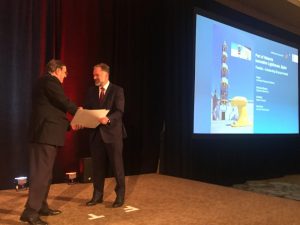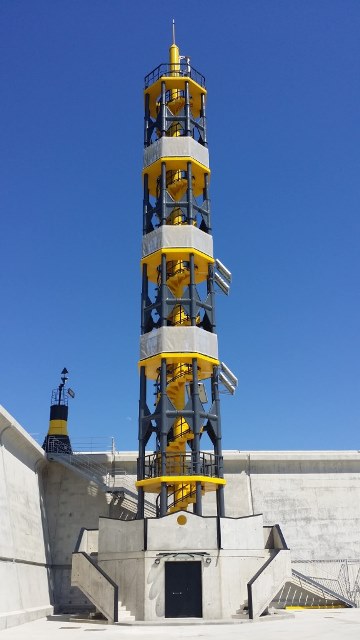
This recognition joins the JEC World 2016 Innovation Awards in the infrastructure category.
Valencia, October the 4th 2017. – The new lighthouse of the port of Valencia has been finalist in the annual awards organized by the IABSE, the International Association of Bridges and Structural Engineering. The award, which was presented in Vancouver (Canada), recognizes innovation in the design and construction of the lighthouse located in the northern extension of the port of Valencia.
This recognition joins the award obtained in 2016 at the JEC World Innovation Awards, the most important awards in the world in the field of composite materials. The lighthouse, designed by the architect Ignacio Pascual, Director of Infrastructure of the Port Authority of Valencia, is the first in the world built entirely with composite materials such as carbon fiber and fiberglass, which gives it great lightness, with only 3,000 kilos weight. In this sense, the use of composites ensures greater resistance to exposure of marine environments as they are not affected by corrosion, less maintenance work and a 20% reduction of CO2 emissions in the construction process require less displacement of heavy materials.
The new facility has LED technology, allowing a range of 25 nautical miles, with a power consumption of 70 watts and a lifespan of 100,000 hours. It is also self-sufficient when using renewable energy. Specifically, the lighthouse incorporates ten solar panels oriented energetically to the south and a vertical axis auto-generator, which contributes to significantly reduce its energy consumption.

Construction
The constructive process, pioneering in the world, has allowed reducing about 50% the duration of the works. This PAV project led by Ignacio Pascual was joined by technicians from the former Valencian Construction Institute, AIDICO and the Technological Institute of Plastic, AIMPLAS; both organisms of Valencia Parc Tecnològic. In fact, AIMPLAS provided technical assistance during the development and construction of the infrastructure.
Since Spain had not developed construction regulations applicable to “composites”, resorted to collaboration of Diegrist and Moreno Design Company, who knew the German and English regulations for these new materials.
The Port Authority of Valencia contracted the construction of the structure to Acciona Infraestructuras, which developed each of the pieces at its I + D center in Alcobendas (Madrid). Later it was mounted in the plant of Acciona de Noblejas (Toledo) and moved, in a single piece and by road, to the port of Valencia in a special transport. The lifting of the infrastructure was completed in less than 3 hours so the impact on the operation of the port was very small.

